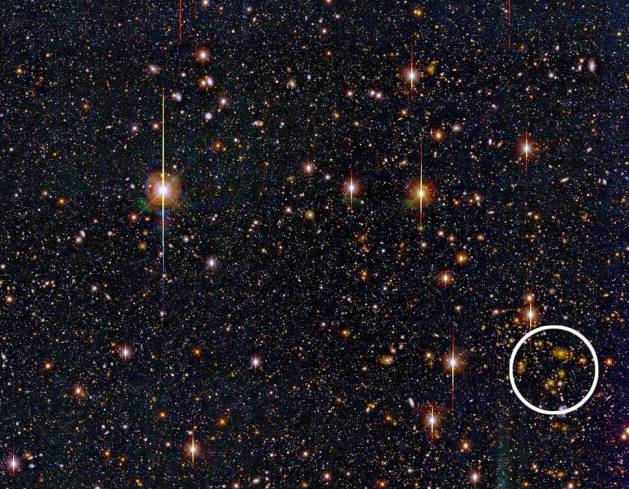Explanation: This stunning color deep sky view toward the constellation Pisces was made with data from a fast, sensitive, digital detector known as the Big Throughput Camera operating at Cerro Tololo Inter-American Observatory in Chile. Hardly noticeable in the original picture is the small cluster of about 15 galaxies nearly 3 billion light-years distant, circled at the lower right. In fact, this distant cluster was not discovered by noticing its appearance in the image at all, but instead by mapping the subtle distortions created by its gravity. As predicted by Einstein's General Relativity theory, the cluster's gravitational mass acts like a lens, bending light and distorting the shape of background galaxies. The effect is known as gravitational lensing. Computer mapping of weak distortions of background galaxy shapes across the Big Throughput image revealed that the large scale distribution of mass in that part of the sky was concentrated in a small region. That region turned out to correspond to the galaxy cluster -- the first time such an object has been discovered on the basis of its mass properties rather than its light.
1999 2000 2001 2002 2003 2004 2005 2006 2007 2008 2009 2010 2011 2012 2013 2014 2015 2016 2017 2018 2019 2020 2021 2022 2023 2024 2025 |
Yanvar' Fevral' Mart Aprel' Mai Iyun' Iyul' Avgust Sentyabr' Oktyabr' Noyabr' Dekabr' |
NASA Web Site Statements, Warnings, and Disclaimers
NASA Official: Jay Norris. Specific rights apply.
A service of: LHEA at NASA / GSFC
& Michigan Tech. U.
|
Publikacii s klyuchevymi slovami:
gravitational lens - galaxy cluster - Skoplenie galaktik - gravitacionnaya linza
Publikacii so slovami: gravitational lens - galaxy cluster - Skoplenie galaktik - gravitacionnaya linza | |
Sm. takzhe:
Vse publikacii na tu zhe temu >> | |
